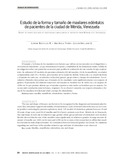| dc.rights.license | http://creativecommons.org/licenses/by-nc-sa/3.0/ve/ | |
| dc.contributor.author | Bustillos R., Lorena | |
| dc.contributor.author | Terán, Ana Adela | |
| dc.contributor.author | Arellano G., Leylan A. | |
| dc.date.accessioned | 2008-12-01T21:10:40Z | |
| dc.date.available | 2008-12-01T21:10:40Z | |
| dc.date.issued | 2008-12-01T21:10:40Z | |
| dc.identifier.issn | 1856-3201 | |
| dc.identifier.uri | http://www.saber.ula.ve/handle/123456789/26366 | |
| dc.description.abstract | El tamaño y la forma de los maxilares son factores que deben ser reconocidos en el diagnóstico y en el plan de tratamiento, ya que determinan el soporte y estabilidad de las dentaduras totales, la falta de investigación sobre este particular en nuestro país, justifica la realización de este estudio de tipo exploratorio. Se utilizaron 125 modelos de pacientes edéntulos (63 del maxilar y 62 de la mandíbula), en edades comprendidas entre 45 y 90 años, provenientes de la ciudad de Mérida, Venezuela y se estudió la forma y el tamaño de cada uno, en relación con la edad, género, grupo étnico y tiempo de edentulismo. Los resultados obtenidos demuestran que el tamaño de los maxilares varía significativamente con respecto al género. El promedio del diámetro transverso del maxilar en hombres fue de 4,904 cm y en mujeres de 4,658 cm; lo que permite afirmar que el maxilar superior es más ancho en hombres que en mujeres. No se encontró correlación entre la forma y el género. No se observó variación con respecto al tamaño y forma de los maxilares al relacionar edad y tiempo de edentulismo. | es_VE |
| dc.rights | info:eu-repo/semantics/openAccess | |
| dc.subject | Maxilar | es_VE |
| dc.subject | Mandíbula | es_VE |
| dc.subject | Edentulismo | es_VE |
| dc.subject | Tamaño y forma | es_VE |
| dc.title | Estudio de la forma y tamaño de maxilares edéntulos de pacientes de la ciudad de Mérida, Venezuela | es_VE |
| dc.title.alternative | Study of shape and size of edentulous maxillaries in patients from Mérida city, Venezuela | es_VE |
| dc.type | info:eu-repo/semantics/article | |
| dc.description.abstract1 | The size and shape of the jaws are factors to be recognized in the diagnosis and treatment plan because they determine support and stability of total dentures. Lack of research about the issue in our country justifies conducting the present exploratory study. 125 models of edentulous patients between 45 and 90 years of age were used (63 of maxillas and 62 of jaws), patients were from Mérida city in Venezuela. Size and shape of each one in relation to age, gender, ethnic group and time of edentulism were studied. Results showed that the size of the maxillas varies significantly in relation to gender. Average traverse diameter of maxilla was 4,904 cm for men and 4,658 cm for women; it lets researchers to affirm that maxilla is broader in males than in females. No correlation between form and gender was found. No variations regarding size and form of the maxillas related to age and time of edentulism were observed. | es_VE |
| dc.description.colacion | 20-25 | es_VE |
| dc.description.email | bustillo@ula.ve | es_VE |
| dc.description.email | leylan@ula.ve | es_VE |
| dc.description.frecuencia | semestral | |
| dc.identifier.depositolegal | 200502ME2052 | |
| dc.subject.facultad | Facultad de Odontología | es_VE |
| dc.subject.keywords | Maxillas | es_VE |
| dc.subject.keywords | Mandibular | es_VE |
| dc.subject.keywords | Edentulism | es_VE |
| dc.subject.keywords | Size and shape | es_VE |
| dc.subject.publicacionelectronica | Revista Odontológica de Los Andes | |
| dc.subject.seccion | Revista Odontológica de Los Andes: Trabajos de Investigación | es_VE |
| dc.subject.tipo | Revistas | es_VE |
| dc.type.media | Texto | es_VE |


